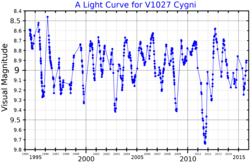V1027 Cygni
| Observation data Epoch J2000 Equinox J2000 | |
|---|---|
| Constellation | Cygnus |
| Right ascension | 20h 02m 27.376s[2] |
| Declination | +30° 04′ 25.49″[2] |
| Apparent magnitude (V) | 8.6-9.6[1] |
| Characteristics | |
| Evolutionary stage | Yellow supergiant |
| Spectral type | G7Ia[3] |
| U−B color index | +1.9 – +2.8[1] |
| B−V color index | +2.1 – +2.5[1] |
| Variable type | L[4] |
| Astrometry | |
| Proper motion (μ) | RA: −2.936[2] mas/yr Dec.: −5.55[2] mas/yr |
| Parallax (π) | 0.2390 ± 0.0178 mas[2] |
| Distance | 14,000 ± 1,000 ly (4,200 ± 300 pc) |
| Absolute magnitude (MV) | −7.956[3] |
| Details | |
| Radius | 474[5] R☉ |
| Luminosity | 176,200[3] L☉ |
| Surface gravity (log g) | −0.81[6] cgs |
| Temperature | 5,000[3] K |
| Other designations | |
| Database references | |
| SIMBAD | data |
V1027 Cygni is a luminous yellow supergiant star located in the constellation of Cygnus, about 14,000 light years away. For a time, it was thought that it could be a low-mass post-AGB star, however recent parallax measurements published in Gaia DR3 have shown this to likely not be the case, and instead it is likely a massive yellow supergiant star.[3]
Properties[edit]
V1027 Cygni has a surface temperature about 5,000 K, which has been found in many studies. However, studies before Gaia DR3 generally used a distance around 1,280 pc, which led to low luminosity estimates, hence a tentative post-AGB star status.[1] Recent Gaia DR3 data shows that V1027 Cygni is likely much further away, over 4,000 pc away, which implies a much higher luminosity (about 176,000 L☉) which would place it firmly outside the post-AGB star luminosity range and in that of the more massive, younger yellow supergiants.[3] Spectral indicators of luminosity also suggest a supergiant status.[1]
Assuming a temperature of 5,000 K and a luminosity of about 176,200 L☉ for V1027 Cygni leads to a size of about 560 times that of the Sun.[a] In the TESS Input Catalog (TIC) from 2019 the star's radius was calculated to be 474 R☉.[5]
Variability[edit]
When V1027 Cygni was first noticed as a variable star, it was thought to be an irregular variable, dimming and brightening erratically with no discernible period. However, in 2009, a small-amplitude period of 237 days was observed in long-term photometry of the star.[1]
Notes[edit]
- ^ Applying the Stefan–Boltzmann law with a nominal solar effective temperature of 5,772 K:
References[edit]
- ^ a b c d e f g Arkhipova, V. P.; Taranova, O. G.; Ikonnikova, N. P.; Esipov, V. F.; Komissarova, G. V.; Shenavrin, V. I.; Burlak, M. A. (2016-11-01). "Photometric and spectroscopic study of the supergiant with an infrared excess V1027 Cygni". Astronomy Letters. 42 (11): 756–773. arXiv:1609.09279. Bibcode:2016AstL...42..756A. doi:10.1134/S1063773716100017. ISSN 1063-7737. S2CID 119185536.
- ^ a b c d e Vallenari, A.; et al. (Gaia collaboration) (2023). "Gaia Data Release 3. Summary of the content and survey properties". Astronomy and Astrophysics. 674: A1. arXiv:2208.00211. Bibcode:2023A&A...674A...1G. doi:10.1051/0004-6361/202243940. S2CID 244398875. Gaia DR3 record for this source at VizieR.
- ^ a b c d e f Parthasarathy, M.; Kounkel, Marina; Stassun, Keivan G. (2022-10-01). "Evolutionary Status of Selected Post-AGB Stars Based on Gaia DR3". Research Notes of the American Astronomical Society. 6 (10): 210. arXiv:2210.00890. Bibcode:2022RNAAS...6..210P. doi:10.3847/2515-5172/ac99dd. ISSN 2515-5172. S2CID 252683050.
- ^ Samus', N. N; et al. (2017). "General catalogue of variable stars". Astronomy Reports. GCVS 5.1. 61 (1): 80. Bibcode:2017ARep...61...80S. doi:10.1134/S1063772917010085. S2CID 125853869.
- ^ a b Stassun, Keivan G.; et al. (9 September 2019). "The Revised TESS Input Catalog and Candidate Target List". The Astronomical Journal. 158 (4): 138. arXiv:1905.10694. Bibcode:2019AJ....158..138S. doi:10.3847/1538-3881/ab3467. ISSN 0004-6256.
- ^ Fouesneau, M.; Andrae, R.; Dharmawardena, T.; Rybizki, J.; Bailer-Jones, C. A. L.; Demleitner, M. (2022). "Astrophysical parameters from Gaia DR2, 2MASS, and AllWISE". Astronomy and Astrophysics. 662: A125. arXiv:2201.03252. Bibcode:2022A&A...662A.125F. doi:10.1051/0004-6361/202141828. S2CID 245837778.


